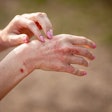Contaminating bacteria are very commonly found on the hands of anesthesia providers, with high rates of transmission to the surgical field during operations, reports a study in the January issue of Anesthesia & Analgesia (January 2011, Vol. 112:1, pp. 98-105).
Randy Loftus, MD, and colleagues at Dartmouth-Hitchcock Medical Center performed a detailed study to determine the origin of bacteria transmitted to the surgical field in 164 operating room procedures using general anesthesia. Using culture tests, they found that bacteria were transmitted to the stopcock valves of the intravenous lines in 11.5% of procedures. In nearly half of these cases, the bacteria found in the intravenous lines were the same as those found on the hands of anesthesia providers: attending anesthesiologists, residents, and nurse anesthetists.
Before the start of the procedure, contamination with potential disease-causing bacteria was found on the hands of anesthesia providers in 66% of cases. Overall, bacteria were transmitted to the intraoperative environment in 89% of procedures. In 12% of these cases, the source of the bacteria was the hands of anesthesia providers.
The study identified several factors associated with an increased risk of bacterial transmission. Transmission was more likely when the anesthesiologist had to supervise more than one room simultaneously, in older patients, and when the patient was sent directly from the operating room to the intensive care unit.
"Contamination of provider hands before patient care ... represents an important modifiable risk factor for bacterial cross-contamination," Dr. Loftus and colleagues wrote. "These findings support initiatives designed to improve intraoperative hand hygiene of anesthesia providers both before and during patient care, as well as intraoperative decontamination strategies."
Copyright © 2010 DrBicuspid.com



















